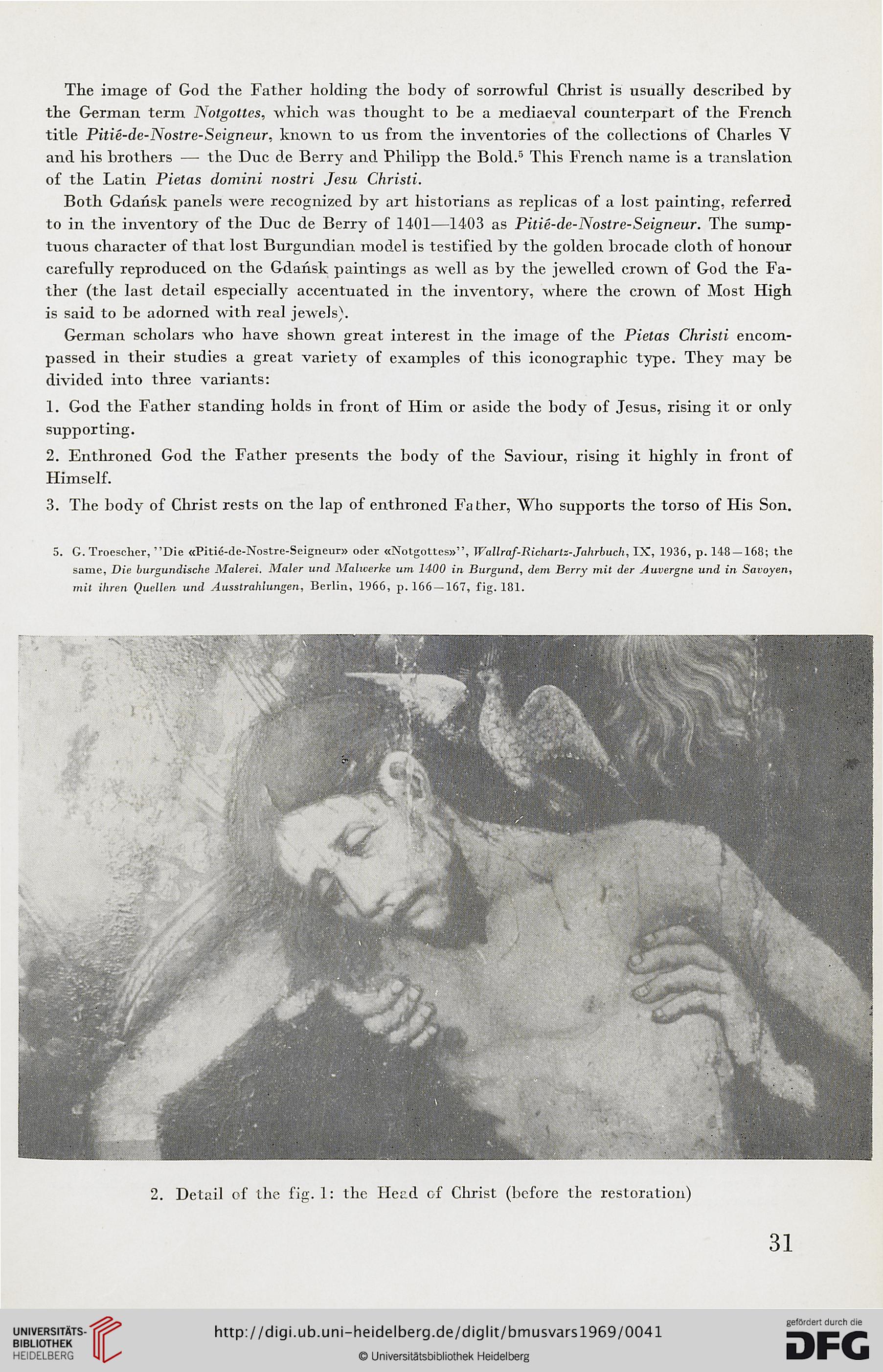The image of God the Father holding the body of sorrowful Christ is usually described by
the German term Notgottes, which was thought to be a mediaeval counterpart of the French
title Pitie-de-Nostre-Seigneur, known to us from the inventories of the collections of Charles V
and his brothers — the Duc de Berry and Philipp the Bold.5 This French name is a translation
of the Latin Pietas domini nostri Jesu Christi.
Both Gdańsk panels were recognized by art historians as replicas of a lost painting, referred
to in the inventory of the Duc de Berry of 1401—1403 as Pitie-de-Noslre-Seigneur. The sump-
tuous character of that lost Burgundian model is testified by the golden brocade cloth of honour
carefully reproduced on the Gdańsk paintings as "well as by the jewelled crown of God the Fa-
ther (the last detail especially accentuated in the inventory, where the crown of Most High
is said to be adorned with real jewels).
German scholars who have shown great interest in the image of the Pietas Christi encom-
passed in their studies a great variety of examples of this iconographic type. They may be
divided into three variants:
1. God the Father standing holds in front of Him or aside the body of Jesus, rising it or only
supporting.
2. Enthroned God the Father presents the body of the Saviour, rising it highly in front of
Himself.
3. The body of Christ rests on the lap of enthroned Fa ther, "Who supports the torso of His Son.
5. G. Troescher, "Dic «Pitie-<Ie-Nostre-Seigneur» oder «Notgottcs»", Wallraf-Richarlz-Jahrbuch, IX, 1936, p. 148 — 168; the
same, Die burgundische Malerci. Maler und Malwerke um 1400 in Burgund, dem Berry mit der Auvergne und in Savoyen,
mit ilircn Quellcn und Ausslrahiungen, Berlin, 1966, p. 166 —167, fig. 181.
2. Detail of the fig. 1: the Head of Christ (bcfore the restoration)
31
the German term Notgottes, which was thought to be a mediaeval counterpart of the French
title Pitie-de-Nostre-Seigneur, known to us from the inventories of the collections of Charles V
and his brothers — the Duc de Berry and Philipp the Bold.5 This French name is a translation
of the Latin Pietas domini nostri Jesu Christi.
Both Gdańsk panels were recognized by art historians as replicas of a lost painting, referred
to in the inventory of the Duc de Berry of 1401—1403 as Pitie-de-Noslre-Seigneur. The sump-
tuous character of that lost Burgundian model is testified by the golden brocade cloth of honour
carefully reproduced on the Gdańsk paintings as "well as by the jewelled crown of God the Fa-
ther (the last detail especially accentuated in the inventory, where the crown of Most High
is said to be adorned with real jewels).
German scholars who have shown great interest in the image of the Pietas Christi encom-
passed in their studies a great variety of examples of this iconographic type. They may be
divided into three variants:
1. God the Father standing holds in front of Him or aside the body of Jesus, rising it or only
supporting.
2. Enthroned God the Father presents the body of the Saviour, rising it highly in front of
Himself.
3. The body of Christ rests on the lap of enthroned Fa ther, "Who supports the torso of His Son.
5. G. Troescher, "Dic «Pitie-<Ie-Nostre-Seigneur» oder «Notgottcs»", Wallraf-Richarlz-Jahrbuch, IX, 1936, p. 148 — 168; the
same, Die burgundische Malerci. Maler und Malwerke um 1400 in Burgund, dem Berry mit der Auvergne und in Savoyen,
mit ilircn Quellcn und Ausslrahiungen, Berlin, 1966, p. 166 —167, fig. 181.
2. Detail of the fig. 1: the Head of Christ (bcfore the restoration)
31




